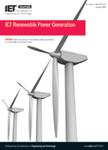版权所有:内蒙古大学图书馆 技术提供:维普资讯• 智图
内蒙古自治区呼和浩特市赛罕区大学西街235号 邮编: 010021

作者机构:Shandong Univ Minist Educ Key Lab Power Syst Intelligent Dispatch & Control Jinan 250061 Shandong Peoples R China State Grid Qingdao Power Supply Co Qingdao 266000 Shandong Peoples R China Shandong Univ Sch Energy & Power Engn Jinan 250061 Shandong Peoples R China
出 版 物:《IET RENEWABLE POWER GENERATION》 (IET. Renew. Power Gener.)
年 卷 期:2019年第13卷第4期
页 面:530-538页
核心收录:
学科分类:0820[工学-石油与天然气工程] 0808[工学-电气工程] 08[工学]
基 金:National Nature Science Foundation of China Fundamental Research Funds of Shandong University [2018JC029]
主 题:energy storage power grids load forecasting wind power plants optimisation power generation economics wind power multiple nearby wind farms correlation model high-dimensional forecast errors spatial-temporal characteristics optimal ESS sizing model optimal sizing spatial-temporal correlation power deviation stochastic wind power forecast error regional power grid energy storage system
摘 要:Energy storage is considered as an effective approach to deal with the power deviation that caused by the stochastic wind power forecast error. Because of the spatial-temporal correlation of forecast errors for wind farms, which locate close to each other and integrate into the same regional power grid, energy storage could be deployed effectively and economically. Therefore, this study proposes an optimisation method to size the capacity of energy storage system (ESS) considering the spatial-temporal correlation of forecast errors for multiple nearby wind farms. The copula theory based correlation model of high-dimensional forecast errors is built to capture the spatial-temporal characteristics of forecast error. Then, according to multiple scenarios technique, an optimal ESS sizing model is established to minimise the investment and operation costs of the ESS. Meanwhile, an operation strategy considering the trend of prediction and correlation of errors is used to implement rolling operation strategy of ESS. The case studies demonstrate the effectiveness of the new method and illustrate the significant impact of the correlation of forecast error on the capacity of ESS.